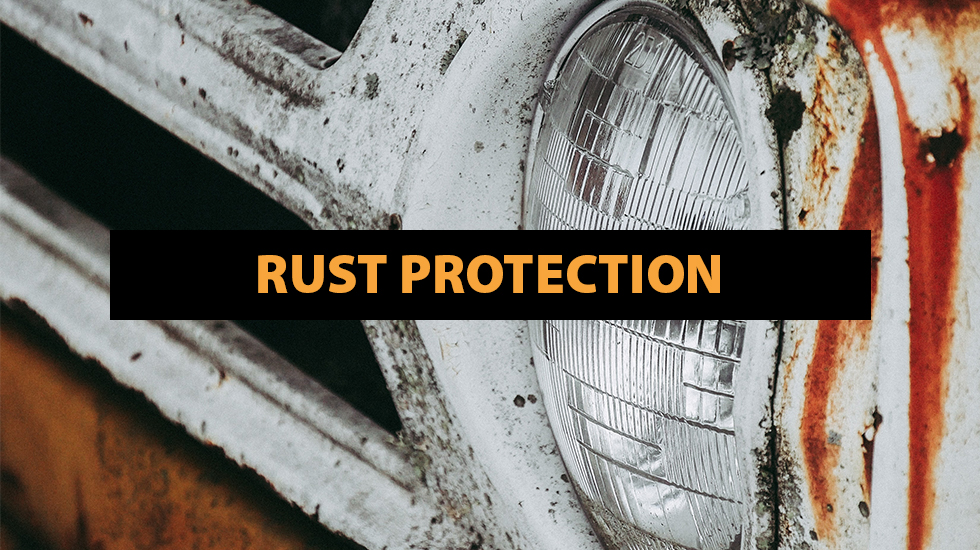| |

By Ian Cushway, 26th November 2018
Get rustproofing!
Tips to keep your classic properly protected.
There's nothing worse than spending time on a restoration only to lie in bed at night with the niggling thought that rust might be about to break through again. That's why it makes sense to keep your vehicle protected underneath, so you can use it all year come rain or shine without the worry.
Out with the old
While many vehicles from the ‘60s and ‘70s had some form of anti-rust treatment, it's likely to have deteriorated by now and can actually be causing more harm than good. Old school bitumen-type underseal can harden and crack with age, and if water gets in behind it will leave the metal beneath exposed to corrosion. Therefore, if you notice it’s getting flaky or you see that it's patchy in places, now's the time to strip it off and apply fresh protection instead. Use a wire brush, scraper or solvent from our range of Cleaning and Stripping products to get it off.
Rust in peace
Once rust has got its wicked way underneath, the best bet is to cut it out and weld in new metal. However, if you find exposed metal with just surface rust, get in quick, halt it and apply protection to prevent it getting any worse. Remove any surface rust first then apply a product from our Anti Rust Paints range.
Flexible friends
Traditionally, most manufacturers relied on a flexible, waxy coating to guard against rust and to an extent, this is still the case today. However, products have evolved over time and now it’s a case of applying specific products to certain areas to get the best form of protection. A thick underseal might be the weapon of choice to protect metal areas that get the most road dirt and water, or, for those who place appearance above function, a hard-drying rubberised stone-chip paint and seam seal can effectively do the same job. A thinner wax can then be squirted into box sections and other cavities such as doors and double skinned sections of bodywork. On modern classics with plastic liners, it might be a case of removing these, clearing out any debris trapped behind, and applying fresh wax. Take a look at our comprehensive Rust Prevention range.
Get it on
Unless you are rust proofing a fresh build in a workshop, application is very much weather dependent because once the underside’s been washed, it needs to be thoroughly dry before products are applied. At this time of year, you may need to resort to using a powerful hairdryer to be sure there's no traces of moisture. Obviously it makes sense to do all this work before fitting any trim so you can access the inside of doors and other usually hidden cavities.
Ideally, it’s best to raise the car on a lift or on sturdy axle stands to treat the floorpans and chassis. Use a spray gun applicator with a long extension probe to access all of the out-of-the-way places. We have just the thing in this Cavity Wax Injector Kit, or even this Eastwood Internal Frame Coating, supplied with extension tube and radial pattern conical nozzle.
If you are using a spray can, be aware that there can be a lot of overspray so mask any bits of bodywork you don’t want covered. Components such as brakes should also be covered with a bin liner so they don’t get contaminated. We recommend the correct Safety Equipment is always worn.
Thinking out of the box
With areas such as sills or box sections, drill a hole to allow you to insert a probe and apply a spray of wax. Use a rubber bung to block them afterwards. Work methodically, so that you cover the entire underside.
Good underseals will be touch dry after a few days and remain flexible to avoid chipping. Coatings that dry completely can be overpainted in the same colour as the rest of the car’s body, which looks great when you look underneath. Here a two-pack epoxy mastic solution is best because it offers protection against stone chips and can even be rubbed down once it’s set.
Bright idea
Finally, here's something you can do to protect you brightwork this winter, as well as your wiring and underbonnet area. Spray a fine coating of PROtecht Corrosion Protection on electrical fittings, polished surfaces, chrome bumpers and engine components to stop corrosion, especially if you are intending to store your vehicle for a while. It repels moisture and can also be applied to rubbers and plastics, so there's no worry about overspray.
Once you've covered in a protective layer of wax or corrosion protection, you can rest assured that all the work you’ve put into your project thus far will last the test of time and possibly be better protected than when it left the factory!.

Keep up with all the latest from Moss on our social pages
|
|








